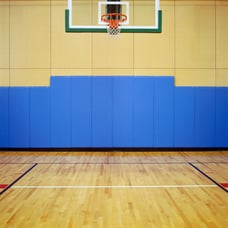During a walkthrough of a brand-new, large community center, one of our loss control reps noticed something about the gym. The entire building had been built in a modern warehouse style, with exposed beams and lots of steel and brick. While this style certainly worked in most areas of the building, there were large, exposed steel beams at various points in the walls around the basketball courts. The gym walls were padded except for these beams, which could have caused serious injury to players on those courts.
Many indoor sports like basketball, volleyball, and indoor soccer have high-speed and high-impact movements which can lead to intense collisions with other players, walls, or equipment. Further, players are often so focused on what they’re doing that they can lose track of their surroundings. This can result in serious injuries and even death if a player collides with something hard, like a wall or steel beam from the story above.
Fortunately, there’s an easy solution that’ll help keep players safe while participating in these types of sports: proper padding. Padding is a key part of keeping participants safe while they’re playing sports. There are many different companies that supply gym padding, which should be installed on the following surfaces:
- Walls around a gym floor
- Hard bleachers or benches
- Any support column, post, or beam
- Goal posts or columns on a volleyball net
This padding should extend up high enough so that even a player who’s jumping still wouldn’t hit bare wall. Padding should be cleaned and inspected regularly for any defects and to ensure it’s still thick enough to protect players. Pads do wear down over time with use so they should be replaced at regular intervals.





